There are various theories about the origin of Japanese family crests. But since the origins of crests differ between court nobles and samurai families, let us begin with the origin of the crests of court nobles.
Table of contents 1. Court Nobles’ Family Crest Origin: Japanese Family Crest2. Why were these family crests established and passed down from generation to generation?
3. Origins of Samurai Family Crests: Japanese Family Crest Japanese Family Crest History The Spread of the Family Crests’ Popularity Indispensable for Samurais
4. The Change of the Family Crest Usage: Japanese Family Crest
3. Origins of Samurai Family Crests: Japanese Family Crest
4. The Change of the Family Crest Usage: Japanese Family Crest
Japanese Family Crest: List of the Lineage Symbols
Japanese Family Crest Consulting Services
Kamon the Avant-garde: Interview with Japanese Family Crest Artisans
Japanese Family Crest Design Service
Court Nobles’ Family Crest Origin: Japanese Family Crest
- Originating from a pattern on an oxcart
- Patterns derived from patterns on clothing
- Those designated explicitly on the basis of commemorative significance
Patterns on Oxcart/Palanquin
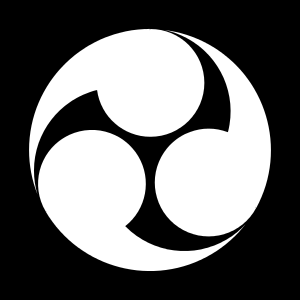
We can find a record of a design on an oxcart of a noble family in Sonpi Bunmyaku (Compilation of genealogical records of various families compiled during the era of 1336-1392). The Saionji family created their Tomoe family crest out of a pattern on their oxcart during the reign of Sanesue. Also, the Tokudaiji family crest was created as an oxcart pattern from 1096 to 1159.
The Tokudaiji family used the design on their oxcarts and clothing. By the end of the Kamakura period (1185-1333), it had become the family crest.
The use of the pattern on an oxcart or palanquin by court nobles seems to have gradually increased from 1086 to 1333. First, they used the pattern as a decoration.
However, it naturally took on the characteristics of a family crest when it was passed down from generation to generation. Only his legitimate heirs could inherit the design on an oxcart of the Saionji family. This pattern became the family mark and became a family crest.
In short, the court nobles began using their crests from the Insei period (1086-1185) to the Kamakura period (1185-1333). Those patterns on their oxcarts/palanquins generally became their family crests in later periods. It is, therefore, fair to say that the shift from the design on an oxcart to the family crest is the origin of the court nobles’ family crest.
Patterns on Clothing
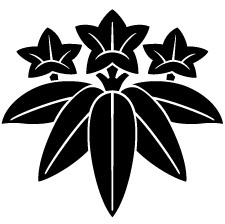
However, while some family crests were derived from oxcarts’ patterns, the majority was derived from patterns on clothing. The family crests in use today, such as the wisteria circle, Japanese Gentian, Chinese flower, creeping wood-sorrel, maple, peony, clove, apricot leaf, and crane circle, were all used as patterns on clothing in those days.
For example, it is known that the Kuga family used Rindo-Tasuki (Japanese Gentian with cords) as a pattern on their clothing during the Michitaka period. The Kuga family later split up and became the eight families of Rokujo, Kuze, Umetani, Iwakura, Chigusa, Atago, Higashikuze, and Uematsu. All of them adopted Japanese Gentians as their family crests.
Commemorative Significance
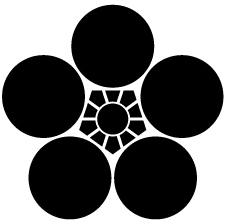
Furthermore, in some cases, family crests were established based on commemorative significance and the patterns on vehicles and clothing. For example, the Sugawara family, or the Takatsuji, Karahashi, Kiyooka, and Kuwabara families of the Suga clan, use the plum pattern crest based on the commemorative significance. Michizane, the ancestor of the Sugawara clan, loved the ume plum tree in his lifetime.
Michizane named his study house Kobaiden (Red Plum Hall), and the Waka poems about plum trees he created still exist. Therefore, people under the Sugawara family chose crests based on the plum blossoms. It is a good example of a family crest created based on commemorative significance.
Why were these family crests established and passed down from generation to generation?
Court nobles used these crests not only for aesthetic purposes but also to distinguish themselves from others and as a mark in case of congestion. Additionally, the class system dominated the period, so they had to show their dignity. The mentality of the court nobles at that time was full of pride and self-respect, and they were determined not to be followed in any matter by others.
Origins of Samurai Family Crests: Japanese Family Crest
- It mainly originated as insignia on flags and banners
- Converted from patterns on clothing
From the end of the 11th century to the end of the 12th century, when the two major powers, the Minamoto and Taira clans, coexisted and then came into conflict, a marker to identify the two on the battlefield became necessary.
For this reason, the Minamoto clan used the white marker, while the Taira clan used the red marker. The Minamoto clan used white markers during the reign of Minamoto no Yoriyoshi. The Heiji Monogatari (Tale of Heiji) describes the Taira clan’s use of the red color. They used white and red colors to mark their factions.
The Minamoto clan defeated the Taira clan at Dannoura in 1185. However, the Minamoto clan’s legitimacy was severed in 1219 when Sanetomo was murdered. Both clans ended without using their family crests.
When did the samurai clans begin to use family crests? The Minamoto and Taira clans simply used colors and did not use symbols as in later times. However, some of the warriors on the shogunate’s side had already drawn patterns/symbols on their flags tagging their own families.
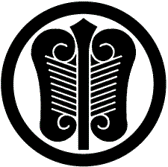
One example is the fan banner used by the Kodama clan in Musashi. Later, the families that emerged from the Kodama clan, the Kodama, Okudaira, and Sho clans, all used the military fan crest. It indicates that what was originally a flag insignia later became the family crest.
The family crests of the warrior clans mainly originated from the symbol on flags and banners. However, some of them, like the crests of the nobles, were adapted from patterns on their clothing. The Kumagai clan crest, ‘dove in mistletoe,’ is an example. The Sasaki clan also used the meyui (tie-dying pattern) crest as a pattern on its flowing robe under Sasaki Takatsuna’s reign. Later, all members of the Sasaki clan came to use the meyui Kamon.
Japanese Family Crest History
Court nobles established their family crests earlier than the samurai families, but the development of the Kamon was conversely slower. Since Minamoto no Yoritomo established the samurai Kamakura shogunate, the court nobles gradually withdrew from power.
The court nobles had the family crest usage only for palanquins and harnesses. Since the Ashikaga clan, the palanquins have fallen into disuse. Also, we can see no records of family crests of the court nobles around this time, making it impossible to learn about their history.
On the other hand, samurai families used their family crests on flags and curtains. Many conflicts occurred after the Kamakura shogunate let people have a lot of opportunities to see and hear them then.
According to the Genpei Seisuiki, no samurai of that time (the 12th century) used their family crest, except for Kumagai and Kodama. However, by the middle of the Kamakura period (1185-1333), most of the Kamakura shogunate’s warriors began to use their family crests.
1203 saw the Hiki Yoshikazu Incident, in which all Kamakura samurais who gathered at the residence of the shogunate and regent Hojo Yasutoki, upon learning of the incident, brought their family crests.
Considering that Yasutoki admonished them, took custody of the flags with the family crests, and returned them to their owners, we can imagine that each flag had a family crest as an owner’s marker.
In those days, samurais using family crests were not necessarily limited to those in Kamakura but were also widely practiced throughout Japan. The Moko Shurai Emaki (Picture Scroll of the Mongol Invasion) shows that all the great warriors in the western part of Japan also used family crests.
Thus, samurais gradually used the family crests from the early Kamakura period. By the middle of the Kamakura period, Kamakura and western samurai used family crests.
The Spread of the Family Crests’ Popularity
By the end of the Kamakura period (1185-1333), all-powerful families in the country began to use their family crests. People came to be familiar with these crests throughout the country.
In warfare, they would draw the Kamon of a powerful family near the enemy soldiers to deceive them, or they would check the flags discarded by enemy generals to detect their movements in advance.
Family crests were painted on military flags, small flags, helmet sleeves, and armor sleeves to distinguish friends from foes. People even used them as helmet marks.
By the Nanbokucho period (1336-1392), general people knew the great samurais’ family crests. People used the family crest as if it were a synonym for the family name. In Taiheiki, a famous military chronicle of the time, family crests are often used in place of surnames when describing the military actions of warriors.
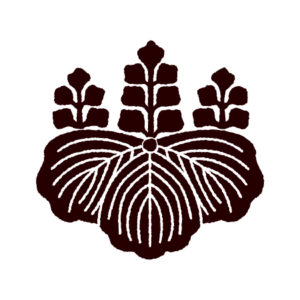
The Chrysanthemum and Paulownia crest, which later became an authoritative imperial crest, had been used since the early Kamakura period (1185-1333). At that time, it was used as a private crest and painted only on clothing and vessels.
However, they used the sun and moon crest on flags for official use in public. Yet, by the time of the Nanbokucho period (1336-1392), the Imperial family had already begun the Chrysanthemum and Paulownia crest. They seemed to give it to the generals of distinguished merit on occasion.
In this way, during the Nanbokucho period, the family crests became significant symbols of the family, both public and private. They were given to reward generals for their merit, thus naturally gaining authority.
Accordingly, samurais developed the ritual of respecting the history of the banner or curtain attached to the family crests. Formerly, samurais used the family crests as a marker of the family name, and they used the same crest among the same clan members.
However, from the Nanbokucho to the Ashikaga period, the clans began to separate and fight each other. Then, to avoid confusion, they created the different crests to distinguish them even among the same clan.
Indispensable for Samurais
In the mid-Muromachi period, family crests became progressively indispensable for military purposes. Military chronicles written in this period all describe the crests of various generals.
In particular, Hatsugihara Kassenki (Battle of Hatsugihara) depicts various generals’ crests. Later, the first book on the Kamon Kenmon Shokamon was published in the Higashiyama period.
It was also known as Ashikaga Bakumon (Ashikaga Shogunate Crests). It lists the crests of various families up to 255 as seen and heard by Ashikaga Shogunate officials. This book is a vital record for understanding the numerous Kamons in the Higashiyama period.
However, it doesn’t cover Kyushu or Tohoku regions. It may be because the Hosokawa and Miyoshi clans were in control of the Shikoku region and had contact with the Shogunate in Kyoto, which may have contributed to the author’s knowledge of the region.
During the Warring States period (around the 15th century), warlords’ rivalry intensified. To control local families, they studied the crests of their rivals.
When Uesugi Kenshin, the lord of Echigo, conquered the Kanto region in 1561, he compiled a list of the family crests of the great lords of the Kanto region. The book contains the Kamon of 251 families centering on Kozuke and Shimotsuke, extending to Musashi, Awa, Kazusa, Shimousa, and Hitachi.
In other regions of Japan, such as Awa, the Awa Kika Bakumon Hikae (The Family Crest Record in Awa Province) was compiled in the 1570s, recording the family crests of the various generals under the Miyoshi clan.
The Change of the Family Crest Usage: Japanese Family Crest
In the 1460s, samurais began using banners in addition to flags. Later, they put their family crests on many tools. In the Edo period (1603-1867), as warfare subsided, flags, banners, and everything related to battle became unnecessary. Hence, the use of crests changed.
Since then, they have been using them mainly to regulate dignity. In particular, after the shogunate government established the alternate attendance system, in which feudal lords traveled to and from Edo or ascended the castle, they always used their family crests and their sashes.
It’s because they needed to display their family names. Since the etiquette of the daimyo differed according to their family status, it was necessary to know the family status of the daimyo in advance in case they met on the way to the castle.
Thus, the lords had followers who were well-versed in their family crests. They made every effort to avoid negligence in their manners and etiquette.
Additionally, the shogunate government assigned a man at the front gate to confirm the lords’ Kamon to inform them in advance of their arrival at the castle.
Contrasting Crest Shape and Adding a Circle
Traditionally, samurais had family crests on flags and curtains, so they didn’t need a contrasting shape. In the Warring States period (the 15th century), however, a clothing system of ceremonial dress and shoulder gowns arose.
They started painting the family crests on these garments, and the Kamon gradually took on a more formal shape. In the Tokugawa period (1603-1867), samurais under the feudal lords usually wore dresses with three or five family crests, which generally resulted in contrasting crest shapes. Adding a circle to the family crest also became common around this time.



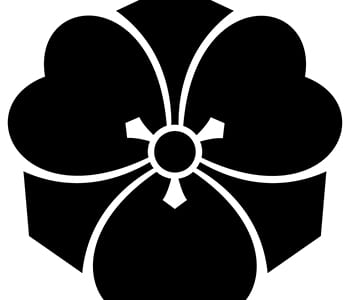
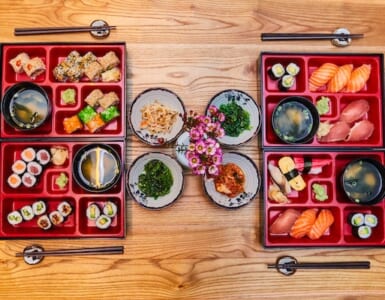
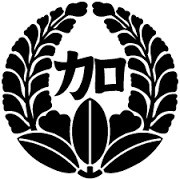


Add comment